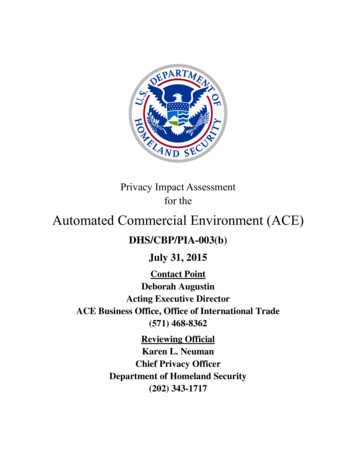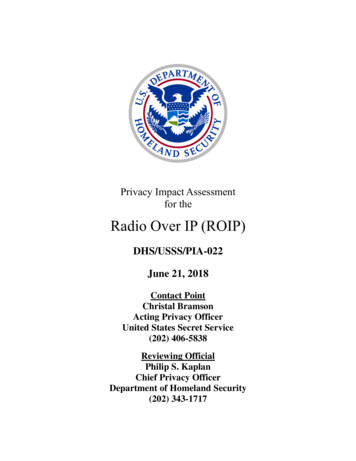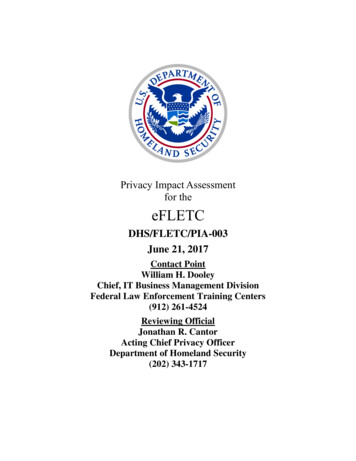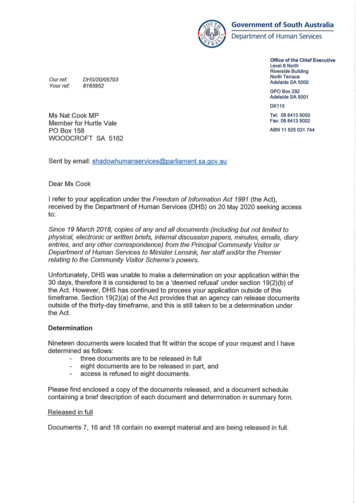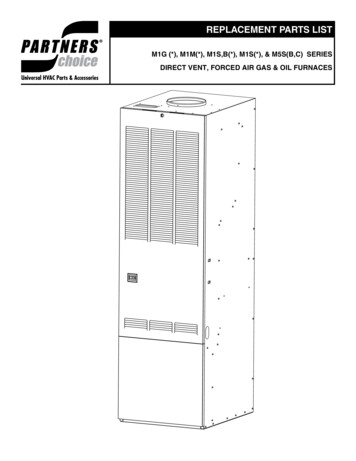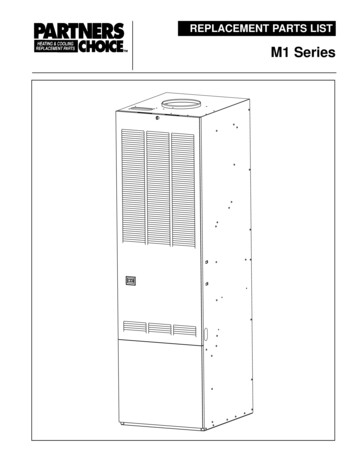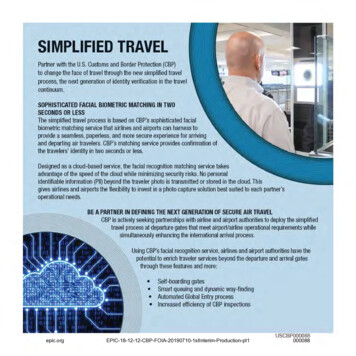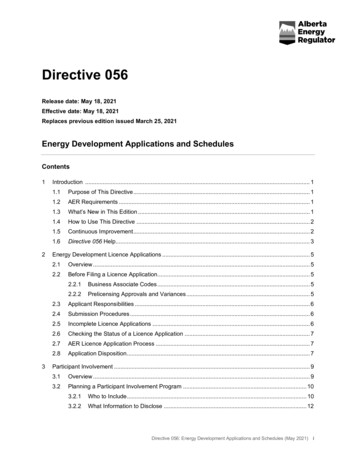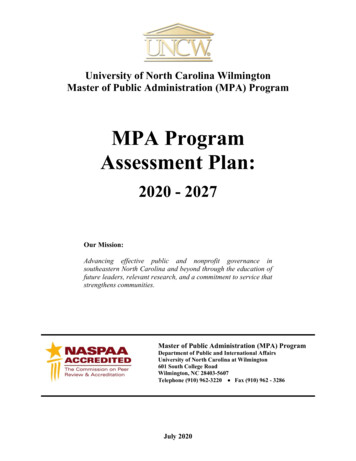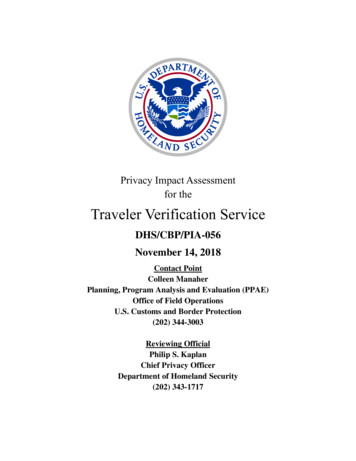
Transcription
Privacy Impact Assessmentfor theTraveler Verification ServiceDHS/CBP/PIA-056November 14, 2018Contact PointColleen ManaherPlanning, Program Analysis and Evaluation (PPAE)Office of Field OperationsU.S. Customs and Border Protection(202) 344-3003Reviewing OfficialPhilip S. KaplanChief Privacy OfficerDepartment of Homeland Security(202) 343-1717
Privacy Impact AssessmentDHS/CBP/PIA-056 Traveler Verification ServicePage 1AbstractThe U.S. Department of Homeland Security (DHS), U.S. Customs and Border Protection(CBP) is congressionally mandated to deploy a biometric entry/exit system to record arrivals anddepartures to and from the United States. Following several years of testing and pilots, CBP hassuccessfully operationalized and deployed facial recognition technology, now known as theTraveler Verification Service (TVS), to support comprehensive biometric entry and exitprocedures in the air, land, and sea environments. CBP has issued Privacy Impact Assessments(PIA) documenting each new phase of TVS testing and deployment. CBP is now issuing thiscomprehensive PIA to a) consolidate all previously issued PIAs and b) provide notice to the publicabout how TVS collects and uses personally identifiable information (PII). CBP is conducting thisoverarching, comprehensive PIA for the TVS that will replace all previous PIAs and provide aconsolidated privacy risk assessment for TVS.OverviewThe 1996 Illegal Immigration Reform and Immigrant Responsibility Act1 authorized theU.S. Government to use an automated system to record arrivals and departures of non-U.S. citizensat all air, sea, and land ports of entry. CBP is also authorized to collect biometric entry and exitinformation pursuant to numerous laws, including the 2002 Enhanced Border Security and VisaEntry Reform Act,2 the Intelligence Reform and Terrorism Prevention Act of 2004,3 and theImplementing Recommendations of the 9/11 Commission Act of 2007.4 Although CBP has beencollecting biometric information on entry since 2004,5 in 2013 CBP began developing and testingnew processes and capabilities for using biometric information, specifically facial recognitiontechnology, to verify the departure of persons leaving the United States. The ConsolidatedAppropriations Act of 20166 authorized CBP to expend up to 1 billion in certain visa feesurcharges collected over the next ten years for biometric entry and exit implementation. ExecutiveOrder 13780, “Protecting the Nation from Foreign Terrorist Entry into the United States,” requiredDHS to “expedite the completion and implementation of a biometric entry/exit tracking system forin-scope travelers to the United States.”7Perhaps the most challenging aspect to deploying a nationwide biometric entry/exit systemis the myriad differences in logistics and locations where travelers depart the United States. Even1Pub. L. 104-208.Pub. L. 107-173.3Pub. L. 108-458.4Pub. L. 110-53.5See DHS/NPPD/PIA-001 US-VISIT Program, Increment 1 (January 16, 2004), available at www.dhs.gov/privacy.6Pub. L. 114-113.7Executive Order 13780, Protecting the Nation from Foreign Terrorist Entry into the United States, 82 FR 13209(March 9, 2017), available at orist-entry-united-states.2
Privacy Impact AssessmentDHS/CBP/PIA-056 Traveler Verification ServicePage 2limited to the air environment only, each airport authority is different and manages its departuregates in different ways. CBP’s collection of biometrics for entry and exit processing poses anumber of logistical challenges. First, CBP Officers (CBPO) must process a large volume oftravelers in a relatively short period. Second, although infrastructure exists to conduct thoroughtraveler inspections upon entry to the United States, there has not been such an infrastructure foroutbound travelers. Third, the collection of biometrics is a privacy-sensitive practice, withheightened concern on behalf of U.S. citizens, and outbound travelers who are not accustomed toCBP inspection at exit. CBP must tackle these practical challenges with the congressional mandateto implement a comprehensive biometric entry/exit program.In addressing these challenges, CBP spent several years testing various technologies invarious locations to determine which technology could be deployed large-scale without disruptinglegitimate travel and trade, while still meeting the biometric exit mandate.Early Test DeploymentsIn June 2016, CBP piloted the Departure Information System Test (DIST)8 to assesswhether facial comparison technology could confirm a traveler’s exit from the United States. CBPoperated DIST at Hartsfield-Jackson Atlanta International Airport, in cooperation with a majorU.S. commercial airline, and scoped the test to include only one route and to operate untilNovember 2016. For flights operating on this route, CBP placed a CBP-manned camera and tabletcomputer between the boarding pass reader and the aircraft. As travelers checked in for their flight,CBP used passenger manifest data from the Advance Passenger Information System (APIS)9 andgenerated biometric templates from existing traveler photographs, which had been assembled onthe tablet prior to boarding. As travelers passed through the boarding area, the camera took theirphotographs. CBP compared the real-time photographs with the expected travelers’ downloadedbiometric (photo) templates downloaded from the Automated Targeting System-UnifiedPassenger (ATS-UPAX),10 to determine if CBP systems could accurately match live photographswith previously-acquired photos of the same traveler. CBP created no exit records but simply usedthe pilot to assess these matching capabilities. CBP stored the images on the tablet for the durationof the flight and then purged the photos.The initial findings from DIST supported the process as a viable solution to fulfilling themandated biometric exit requirements in certain settings. In addition, the airline provided positivefeedback to CBP, and the process did not substantially delay boarding. Based on these results,8See DHS/CBP/PIA-030 Departure Information Systems Test (June 13, 2016), available athttps://www.dhs.gov/privacy.9See DHS/CBP/PIA-001 Advance Passenger Information System (June 5, 2013), available atwww.dhs.gov/privacy.10See DHS/CBP/PIA-006 Automated Targeting System, available at www.dhs.gov/privacy.
Privacy Impact AssessmentDHS/CBP/PIA-056 Traveler Verification ServicePage 3CBP’s Departure Verification System (DVS)11 operationalized the DIST process and expanded toa number of additional international flights at new airports. DVS allowed CBP to biometricallyconfirm each traveler’s departure from the United States and create an exit record in the traveler’scrossing history. If no match was found, a CBP Officer verified the traveler’s identity through afingerprint capture (for aliens) using a Biometric Exit (BE)-Mobile wireless handheld device12 anda query in the Automated Biometric Identification System (IDENT).13 Alternatively, the CBPOfficer conducted an inspection to ensure the validity of the individual’s travel documents. If theCBP Officer was unable to locate an IDENT fingerprint record, the officer ran a separate criminalhistory check in the Federal Bureau of Investigation’s (FBI) Next Generation Identification14(formerly Integrated Automated Fingerprint Identification System (IAFIS)) and enrolled thefingerprints into IDENT. As CBP verified the identity of the travelers, either through automatedfacial recognition or manual officer processing, the CBP Officer returned the results to therespective CBP systems. CBP conducted full PIAs to assess the privacy risks of both the DIST andthe DVS, and to provide notice to the public about CBP’s ongoing tests of biometric exittechnologies.In 2017, CBP operationalized the process piloted under the DIST and DVS under a newname, TVS, which marked the expansion of facial recognition for biometric exit to sevenadditional airports, as well as the collection of data for operational use.In this context, facial recognition has presented CBP with the best biometric approachbecause it can be performed relatively quickly, with a high degree of accuracy, and in a mannerperceived as less invasive to the traveler (e.g., no actual physical contact is required to collect thebiometric). This approach, as with all biometric collections, poses privacy risks which, asdiscussed below, are mostly mitigated. Nevertheless, CBP’s phased deployment has shown the useof facial recognition technology is successful in a variety of scenarios that meet CBP’s businessrequirements while requiring minimal infrastructure investments and space redesign and minimalimpacts on travelers. Moreover, the phased deployment has allowed CBP to ensure that biometricsare collected, maintained, and used consistent with privacy laws and best practices.11See DHS/CBP/PIA-030(a) Departure Verification System (DVS) (December 16, 2016), available athttps://www.dhs.gov/privacy.12See DHS/CBP/PIA-026 Biometric Exit Mobile Program (July 5, 2018), available at www.dhs.gov/privacy.13See DHS/NPPD/PIA-002 Automated Biometric Identification System (December 7, 2012), available atwww.dhs.gov/privacy.14See Privacy Impact Assessment: Next Generation Identification (NGI) (February 20, 2015), available minal-justice-fingerprint-submissions.
Privacy Impact AssessmentDHS/CBP/PIA-056 Traveler Verification ServicePage 4Traveler Verification ServiceThe TVS is an accredited CBP information technology system that consists of a group ofsimilar systems and subsystems that support the core functioning and transmission of data betweenCBP applications and partner interfaces.15 CBP will use the TVS as its backend matching servicefor all biometric entry and exit operations that use facial recognition, regardless of air, land, or sea.Previously, CBP had considered using different technologies based on the different environmentsin which an individual could present themselves for inspection or exit the United States, but CBPhas determined that the TVS facial matching service works across all CBP operating environments(air, land, and sea).Biometric GalleriesRegardless of the method of entry or exit, e.g., pedestrian, vehicle, cruise ship, vessel, orairplane, the TVS system conducts the backend biometric matching and provides a result todifferent CBP systems depending on the environment. For all biometric matching deployments,the TVS relies on biometric templates generated from pre-existing photographs that CBP alreadymaintains, known as a “gallery.” These images may include photographs captured by CBP duringprevious entry inspection, photographs from U.S. passports and U.S. visas, and photographs fromother DHS encounters.1615Two IT systems under the Federal Information Systems Management Act (FISMA), the TVS and TVS-Internal(TVS-I) Systems, provide similar biometric cloud matching services for CBP entry and exit processing. However, tosimplify the privacy compliance coverage, this PIA covers both the TVS and TVS-I Systems and their subsystems,referring to both systems as the TVS.16U.S. passport and visa photos are available via the Department of State’s Consular Consolidated System. SeePrivacy Impact Assessment: Consular Consolidated Database, available at 93772.pdf. Other photos may include those from DHS apprehensions orenforcement actions, previous border crossings, and immigration records.
Privacy Impact AssessmentDHS/CBP/PIA-056 Traveler Verification ServicePage 5CBP builds “galleries” of photographs based on where and when a traveler will enter orexit. If CBP has access to advance passenger manifest information, the CBP will build galleries ofphotographs based on upcoming flight or vessel arrivals or departures. If CBP does not have accessto advance passenger information, such as for pedestrians or privately owned vehicles at land portsof entry, CBP will build galleries using photographs of “frequent” crossers for that specific portof entry, taken at that specific port of entry, that become part of a localized photographic gallery.Figure 1. TVS uses biographic advanced passenger information system (APIS) manifest data and existing photographs (previous CBPencounters, U.S. Passport, U.S. Visa) to build a flight gallery. Then TVS matches the “live photograph” taken prior to boarding withimages from the gallery associated with the manifest to create a confirmed departure.CBP creates localized photographic galleries using either Advance Passenger InformationSystem (APIS)17 data or CBP-generated lists of frequent travelers at a specific port of entry. Topopulate the localized galleries with photographs, CBP compiles photographs from existing CBPsources from the Automated Targeting System (ATS)18 Unified Passenger Module (UPAX)17See DHS/CBP/PIA-001 Advance Passenger Information System (June 5, 2013), available athttps://www.dhs.gov/privacy and DHS/CBP-005 Advance Passenger Information System, 80 FR 13407 (March 13,2015).18See DHS/CBP/PIA-006 Automated Targeting System (January 13, 2017), available athttps://www.dhs.gov/privacy.
Privacy Impact AssessmentDHS/CBP/PIA-056 Traveler Verification ServicePage 6system. TVS will then generate biometric templates19 for each gallery photograph and store thetemplate, but not the actual photograph, in the TVS virtual private cloud (VPC)20 for matchingwhen the traveler arrives or departs.Collection ProcessDue to the complexities in logistics across the entry and exit environments, CBP willcollect photographs of the arriving or departing traveler via several different iterations dependingon the local port of entry. When the traveler presents him or herself for entry, or for exit, thetraveler will encounter a camera connected to CBP’s cloud-based TVS facial matching service viaa secure, encrypted connection. This camera matches live images with existing photo templatesfrom passenger travel documents. The camera may be owned by CBP, the air or vessel carrier,another government agency (e.g., the Transportation Security Administration (TSA)), or aninternational partner. Once the camera captures a quality image and the system successfullymatches it with historical photo templates of all travelers from the gallery associated with thatparticular manifest, the traveler proceeds to inspection for admissibility by a CBP Officer, or exitsthe United States.CBP owned and operated cameras: CBP has deployed CBP owned and operated camerasin almost all traveler processing scenarios to test TVS. CBP owned and operated cameras, whichwere initially used only in the air exit environment, are now being deployed for the biometriccollection and matching via the TVS in the air entry, land, and sea entry environments as well. Inthe air environment, the major difference between CBP-operated cameras and airline or partneroperated cameras is that in locations in which CBP operates the cameras, CBP Officers are presentto verify identity manually with a wireless BE-Mobile handheld device.21 TVS deployment forprocessing arriving air travelers mirrors the process for air exit, with manifest-based galleries anda similar facial recognition algorithm, but integrates it into CBP’s entry inspection applications.Inbound and outbound processing for travelers on commercial sea vessels (e.g., cruiseships) will resemble the air entry and exit processes, as this travel method is also based on apassenger manifest.While CBP may create APIS manifests on land border crossers via bus or rail, unliketravelers in the air and sea environments, there are no manifests created for pedestrian travelers toassemble a gallery of known travelers. CBP is developing processes that would enable the use ofTVS at the land border; for example, CBP may briefly retain local galleries of travelers who have19A biometric template is a digital representation of a biometric trait of an individual generated from a biometricimage and processed by an algorithm. The template is usually represented as a sequence of characters and numbers.For the TVS, templates cannot be reverse-engineered to recreate a biometric image. The templates generated for theTVS are proprietary to a specific vendor’s algorithm and cannot be used with other vendor’s algorithms.20CBP uses a commercial Virtual Private Cloud (VPC) that is a logically isolated (walled-off) virtual network overwhich CBP administers control.21See DHS/CBP/PIA-026 Biometric Exit Mobile Program (July 5, 2018), available at https://www.dhs.gov/privacy.
Privacy Impact AssessmentDHS/CBP/PIA-056 Traveler Verification ServicePage 7recently crossed at a given Port of Entry and are expected to cross again within a given period oftime.Carrier owned and operated cameras: A number of airlines and airport authorities, some ofwhich are already incorporating the use of traveler photographs into their own business processes,may opt to leverage their own technology in partnership with CBP to facilitate identity verification.In compliance with CBP’s business requirements, these stakeholders deploy their own cameraoperators and camera technologymeeting CBP’s technical specificationsto capture facial images of travelers anduse the TVS matching service foridentity verification. Each camera isconnected to the TVS via a secure,encrypted connection. While the photocapture process may vary slightlyaccording to the unique requirements ofeach participating airline and airportauthority, theITinfrastructuresupporting the backend process is thesame. Please see Appendix B for a full Figure 2. British Airways deployment of “eGates” facial recognitionlist of up-to-date CBP commercial technology in partnership with CBP at Orlando International Airport.partnerships and deployments.Other government Agency-owned and operated cameras: CBP has been working with theTransportation Security Administration (TSA) to test the TVS process for verifying traveleridentities using the TVS camera technology and matching services at the TSA security screeningcheckpoint. Standard TSA security screening procedures have required manual identity checks bythe TSA Transportation Security Officers (TSO). A recent technical demonstration, which servedas a variation of the TVS exit process, leveraged the technologies to automate what has typicallybeen a manual identity verification process for travelers. This demonstration used the APISmanifest data to create a gallery of travelers scheduled to board specified outbound internationalflights during a defined period. The primary difference in the CBP-TSA matching process, asopposed to the process outlined with CBP owned and operated cameras, is that each template willbe matched against multiple galleries, based on that day’s flight manifests for that particularinternational terminal, rather than being matched against the templates for only one departingflight’s manifest. The CBP-TSA matching process is only deployed for international travelers anddoes not impact individuals traveling on domestic flights. Please see Appendix C for a full list ofup-to-date CBP and other government Agency partnerships and deployments.International partner owned and operated cameras: CBP is developing global biometricpartnerships in order to share facial images, as appropriate, in order to enhance security and
Privacy Impact AssessmentDHS/CBP/PIA-056 Traveler Verification ServicePage 8expedite international travel. CBP will leverage biometric data collected by a partnering country’sarrival process and use the shared information to record a biometric exit from the United States,thus facilitating the ability to confirm a biometric departure without major investments ininfrastructure. These partnerships are also helpful in the arrivals context. This initiative can beparticularly useful for CBP in verifying the identity of first-time Visa Waiver Program22 travelers,for whom CBP has no photo available. By obtaining a photo in advance of travel from theinternational partner, CBP can verify the identity of the traveler upon arrival. CBP is developingprograms with select international airlines and foreign countries, in which the international partnermay collect the photos of travelers to the United States at the airport of origin and securely transmitthe facial images to CBP. Please see Appendix D for a full list of up-to-date internationalpartnerships and deployments.For a full description of each collection method, and an up-to-date list of deployments,please see the Appendices of this PIA.Retention and StorageWith the operational deployment of TVS, CBP transmits facial images for in-scopetravelers23 to IDENT for retention as the traveler’s biometric encounter with CBP. DHS alreadyretains all entry photos of in-scope travelers in IDENT in order to create biometric records of entryfor those travelers. In addition, retaining exit photos ensures that CBP can access up-to-date photosof in-scope travelers for more accurate future matching through the TVS. Since 2004, CBP hascollected biometric information in the form of fingerprints and a facial photo on entry for in-scopetravelers; CBP transmits this information to IDENT, where it is stored in association with aFingerprint Identification Number (FIN).24 Each FIN is associated with individual encounters(EID), which represent each interaction between that individual and an IDENT data provider.These encounters include the face image, full name, and gender (which comes from the document22The Visa Waiver Program enables most citizens or nationals of participating countries to travel to the UnitedStates for tourism or business for stays of 90 days or less without obtaining a visa. For more information, e is the requirement to biometrically confirm the departure of “in-scope” travelers. An “in-scope” traveler isany person who is required by law to provide biometrics upon exit from the United States pursuant to 8 CFR235.1(f)(ii). “In-scope” travelers include any alien other than those specifically exempt as outlined in the CFR.Exempt aliens include: Canadian citizens under section 101(a)(15)(B) of the Act who are not otherwise required topresent a visa or be issued a form I-94 or Form I-95; aliens younger than 14 or older than 79 on the data ofadmission; aliens admitted A-1, A-2, C-3 (except for attendants, servants, or personal employees of accreditedofficials), G-1, G-2, G-3, G-4, NATO-1, NATO-2, NATO-3, NATO-4, NATO-5, or NATO-6 visas, and certainTaiwan officials who hold E-1 visas and members of their immediate families who hold E-1 visas unless theSecretary of State and the Secretary of Homeland Security jointly determine that a class of such aliens should besubject to the requirements of paragraph (d)(1)(ii); classes of aliens to whom the Secretary of Homeland Securityand the Secretary of State jointly determine it shall not apply; or an individual alien to whom the Secretary ofHomeland Security, the Secretary of State, or the Director of Central Intelligence determines it shall not apply.24See DHS/USVISIT-004 Automated Biometric Identification System (IDENT), 72 FR 31080 (June 5, 2007).
Privacy Impact AssessmentDHS/CBP/PIA-056 Traveler Verification ServicePage 9number and is not collected by CBP). CBP does not store facial images voluntarily collected fromU.S. citizens under this initiative in IDENT, as U.S. citizens are not considered in-scope.25During the initial phases of the DIST, DVS, and TVS technical demonstration, photos ofU.S citizens were retained for a limited period of time. During the 2017 deployment of the TVS,for instance, facial images of U.S. citizens as well as in-scope immigrants were maintained for upto 14 days in ATS-UPAX for confirmation of travelers’ identities, evaluation of the technology,assurance of accuracy of the algorithms, and system audits. However, CBP does not retain theimages of U.S. citizens once their identities are verified by TVS.26 Only photos of non-U.S. citizensare retained for the full 14 days in ATS-UPAX and for the full retention period in IDENT. Inaddition, within 12 hours, CBP purges all photos, regardless of immigration or citizenship status,from the TVS cloud matching service. Retention is described in more detail in section 5 of thisPIA.TVS Privacy Risk AssessmentAs with all biometric modalities, facial recognition poses a unique set of privacy issues.Facial images can be captured at a distance, covertly, and without consent. Further, facial imagesare ubiquitous, and whereas individuals may take measures to avoid fingerprint and iris collection,there are fewer ways to hide one’s face. The newness of the technology, and differences inreliability for certain demographics in previous applications, raise the bar for testing to ensure thatmatching algorithms are effective. CBP is taking steps to promote data minimization and privacyprotections by using an airline-generated alphanumeric unique ID (UID)27 and other methods todisassociate the biographic information associated with the new facial images, and populating therecord with test biographic “dummy” information. The algorithms have continued to improve theirperformance over time.CBP has also taken a number of steps to ensure that its deployment of the TVS is consistentwith the following privacy best practices:Opt-out provisions: U.S. citizens who do not wish to submit to facial photo capturepursuant to these processes may request alternative processing, which typically involves a manualreview of their travel documents by a CBPO. Prior to admission into the United States, the CBPOmust ensure that the traveler is a U.S. citizen, lawful permanent resident, or is otherwise eligible25CBP does not retain U.S. citizen photos in IDENT pursuant to the entry/exit processes discussed in this PIA.However, pursuant to existing procedures and in accordance with its authorities, CBP transmits photos to IDENT forindividuals in the Trusted Traveler network, including U.S. citizens. See DHS/CBP/PIA-002 Global EnrollmentSystem (GES): Trusted Traveler Program System (August 15, 2017), available at www.dhs.gov/privacy.26Photos of all travelers, including U.S. citizens, are held in secure CBP systems for no more than 12 hours afteridentity verification, in case of an extended system outage.27The UID is generated by either the travel agent, travel website hosting service, or the airline at the time of thereservation. The UID is comprised of a sequential number (which is only valid for the particular airline and thespecific flight), plus the Record Locator, a six-digit code used to access additional information about the traveler.
Privacy Impact AssessmentDHS/CBP/PIA-056 Traveler Verification ServicePage 10for entry, and that the traveler is not attempting to import or export any merchandise in violationof U.S. laws. Similarly, CBPOs may inspect travelers departing the United States in order to createexit records and as required for law enforcement operations. CBP posts information on opt-outprocedures near the point of collection.Deletion of U.S. citizen photos: Once a match is made and notated in the appropriatesystems, U.S. citizens’ photos are retained for no more than 12 hours in the TVS cloud for disasterrecovery purposes, then deleted. CBP retains only a confirmation of the crossing and the associatedbiographic information. No photos of U.S. citizens are retained under this process.Using the TVS enables CBP to biometrically confirm the traveler’s arrival and updates thetraveler record from “reported” to “confirmed” in APIS. CBP also retains entry and exit recordsin ADIS for lawful permanent residents and non-immigrant aliens. Transmission of photos toIDENT for in-scope travelers will begin upon publication of this PIA. Since the commencementof the TVS in early 2017, CBP has retained the historical photos of travelers as well as the phototemplates of newly-captured images within ATS/UPAX. From the beginning of the TVS initiativein early 2017, all newly-captured photos for non-U.S. citizens were deleted from ATS/UPAXwithin 14 days and deleted from the TVS cloud-matching service no later than after the conclusionof the flight. No photos are permanently stored in the TVS cloud matching service.Once the TVS matching process is complete, and the response is returned, the facial imagesof U.S. citizens are immediately deleted from the TVS. CBP does not retain any photos collectedfrom U.S. citizens pursuant to this process. Under the CBP partner process as implemented in thebusiness requirements, CBP does not allow its approved partners such as airlines, airportauthorities, or cruise lines to retain the photos they collect for their own business purposes. Thesepartners must immediately purge the photos following transmittal to the TVS. The CBP partner'ssystem must allow CBP to audit compliance with this requirement.28Routine testing: As technology continues to shift and progress, CBP needs baseline data totest across technology providers over time. CBP regularly tests its facial matching algorithms toensure high performance and maximize match rates while reducing the risk of false positives. CBPhas continued to explore the best modalities and collection methods for implementation of thebiometric entry/exit program. In particular, CBP continues to conduct testing and analysis todetermine the factors that lead to high quality biometric capture that will result in higherconfidence scores. A number of technical demonstrations over the last several years have providedCBP with a baseline of images collected in a live environment that may be compared with imagescollected in other similar CBP demonstrations. Throughout this process, CBP has designed the28If an
15 Two IT systems under the Federal Information Systems Management Act (FISMA), the TVS and TVS-Internal (TVS-I) Systems, provide similar biometric cloud matching services for CBP entry and exit processing. However, to simplify the privacy compliance coverage, this PIA covers both the TVS and TVS-I Systems and their subsystems,

